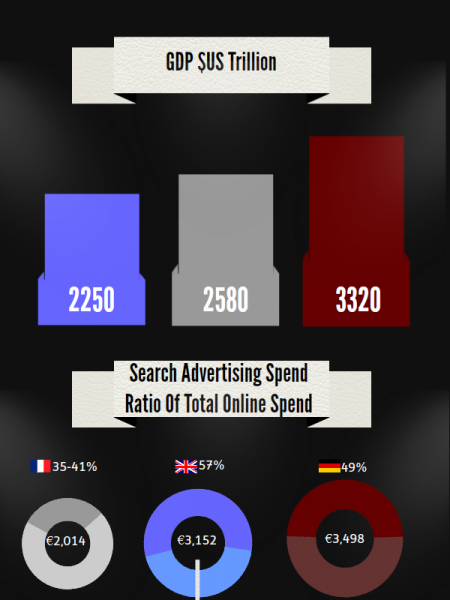
The Future of the European Economy
THE FUTURE HE EUROPEAN ECONOMY infographic This infographic looks at forecasts of six key economic indicators and compares the situation across the European Union. We take as samples Ireland, Germany, Spain and the UK, and also look at the trends prevailing in the Euro 17 and EU 27 as a whole." DEBT TO GDP RATIO How Much Does Europe Owe? This indicator compares a country's level of public debt to its level of economic output. A high ratio of debt to GDP suggests a government that is less likely to be able to pay its debts and hence a higher risk of default. Rising national debts are at the core of Europe's sovereign debt crisis. 140% 120% Ireland Euro17 100% UK EU27 Germany Spain 80% 60%- -4 SGP Target 2010 2011 2012 2013 The EU's so-called Stability and Growth Pact demands that member states keep this ratio at, or "sufficiently declining towards, " 60%. As the above chart shows, lots of national debts are set to remain well above this target. The ones that cause the most concern however are those whose debts are set to continue rising rapidly, such as Ireland and Spain. SGP Target = 60% SGP Target = 60% 66.3% EURO 17 EURO 17 2007 2013 90.9% Comparing the 2007 pre-crisis ratio to the expected ratio in 2013, we can see a dramatic expansion of Eurozone public debt relative to GDP. DEFICIT How Much Are We Borrowing Each Year? A country's fiscal deficit is the difference between how much it raises in taxes and how much it spends on goods, services and interest payments. Deficits must be financed through borrowing. Germany I Ireland I Spain I UK I EU27 Euro17 0% _SGP Target 5% 10% 15% 20% 25% 30% 35% The Stability and Growth Pact also demands that member states keep their annual deficits under 3% of GDP. While many countries managed this in the run up to the crisis, most European states are now struggling to rein in deficits. For example, Ireland comfortably met its SGP targets for many years, even recording substantial budgetary surpluses, but the collapse of its banking system has left it straddled with massive debts, to the extent that its recorded deficit in 2010 was an extraordinary 31.3%. UNEMPLOYMENT Jobless Europe? The unemployment rate is the percentage of the eligible labour force that is unable to find work. 2010 GERMANY 2011 2012 2010 2011 IRELAND 2012 2013 2010 2011 SPAIN 2012 2013 2010 2011 UK 2012 2013 2010 2011 EU27 2012 2013 2010 2011 Euro17 2012 2013 0% 5% 10% 15% 20% 25% Tackling unemployment is fundamental to restoring the EU's economies to health. As with the other indicators, there are wide divergences in unemployment figures across Europe. Spain's rate is set to remain at over 20% until 2013 while Germany's is expected to decline to less than 6%. This chart presents only basic information and does not break down variations across gender, age and geographical region. For more details on these and other aspects of Europe's employment crisis, see our EU unemployment infographic.? CPI Tracking Inflation The consumer price index aims to track the prices paid by a typical household for a basket of goods and services. -1.6% 4.3% HIGHEST LOWEST 2010 2011 2012 2013 GERMANY 1.2 % 2.4 % 1.7 % 1.8 % IRELAND -1.6 % 1.1 % 0.7 % 1.2 % SPAIN 1.1 % 1.3 % UK 3.3 % 4.3 % 2.9 % 2 % EU27 2.1 % 2 % 1.8 % Euro17 1.8 % 1.9 % 1.8 % Movements in the index show whether inflation or deflation is at work in an economy Ireland experienced deflation in 2010, while the EU as a whole experienced modest inflation of 2-3%. GROWTH The Elusive Element Gross domestic product is the most commonly used indicator of economic growth. 4.0 I Ireland I Germany I EU27 I Euro17 I UK I Spain 3.5 3.0 2.5 2.0 1.5 1.0 0.5 -0.5 2010 2011 2012 2013 Growth performance is expected to continue to vary a lot. Economies that have been shrinking, such as Spain and Ireland, are beginning to grow modestly. Meanwhile, Germany's robust growth rate of 3.7% in 2010 will drop to under 1% in 2012. This divergence complicates decision-making by European policymakers but boosting growth across the EU is essential to resolving the debt crisis. GDP PER CAPITA Affluent Europe? GDP per capita is a rough indicator of a country's income level. €40,000+ I Ireland I Germany I EU27 I Euro17 I UK I Spain 35.000- 30,000- €25,000- €20,000- 2010 2011 2012 2013 Although economic forecasts for Europe in the next few years are generally gloomy, European citizens still enjoy a level of income that is very high relative to the rest of the world. Despite the EU's troubles, average income levels are expected to rise slightly in the coming years (though it is important to note that this indicator does not capture income inequality between citizens and can be inflated by high levels of foreign investment, such as exists in Ireland). THE FUTURE OF EUROPEAN ECONOMY infographic 'Data taken from the European Commission's Autumn 2011 European Economic Forecast. http://ec.europa.eu/economy_finance/publications/european_economy/2011/pdf/ee-2011-6_en.pdf Estimated from EUROSTAT (nama_gdp_c] 2Available here: http://www.iiea.com/blogosphere/the-eu-unemployment-infographic Produced by the Institute of International and European Affairs www.iiea.com This infographic forms part of the E View project, which is part-funded by DG Communication of the European Parliament. 010 013 2012 2011
The Future of the European Economy
Source
Unknown. Add a sourceCategory
EconomyGet a Quote









